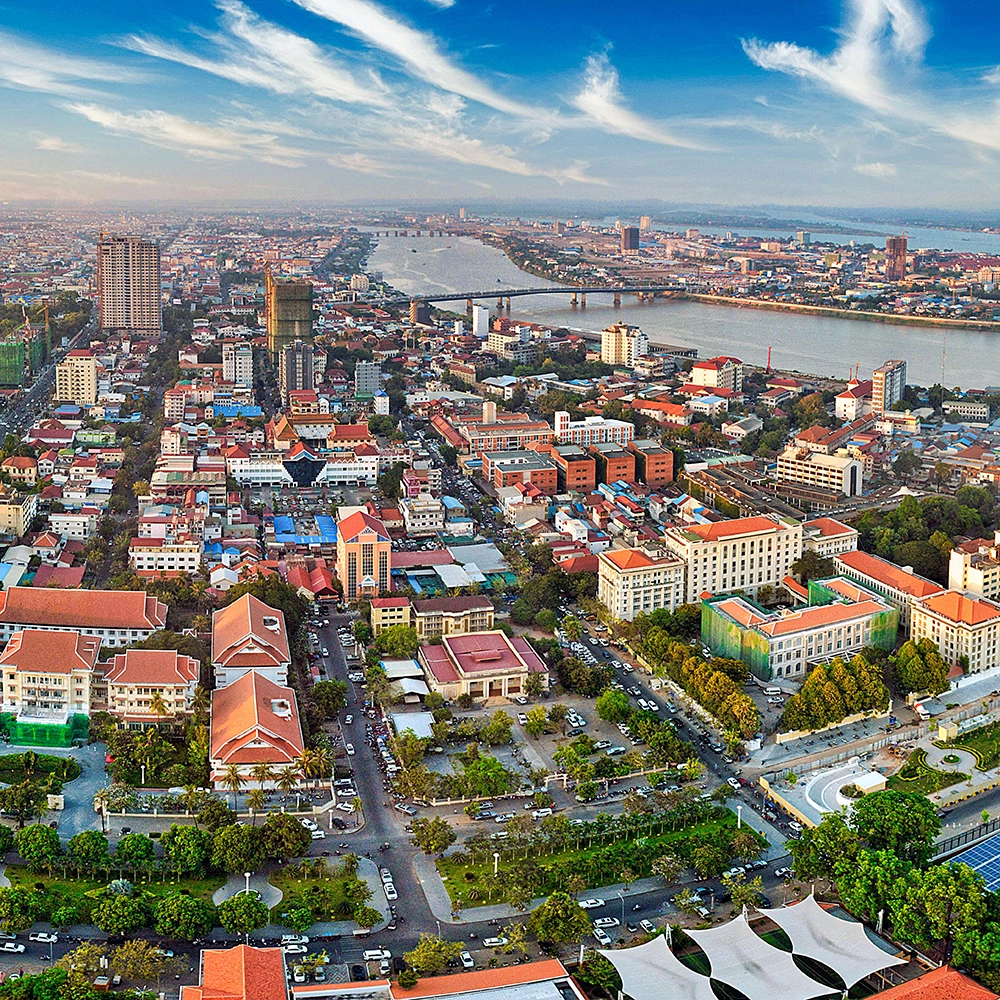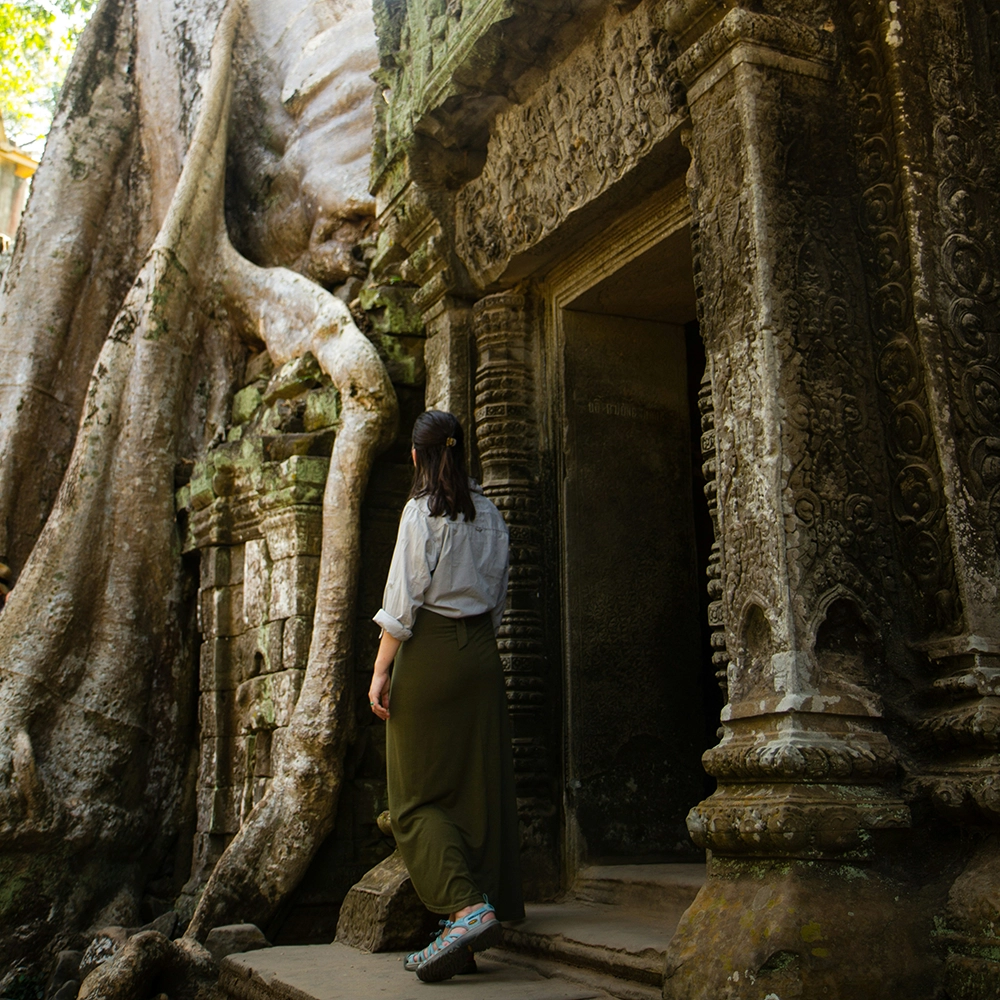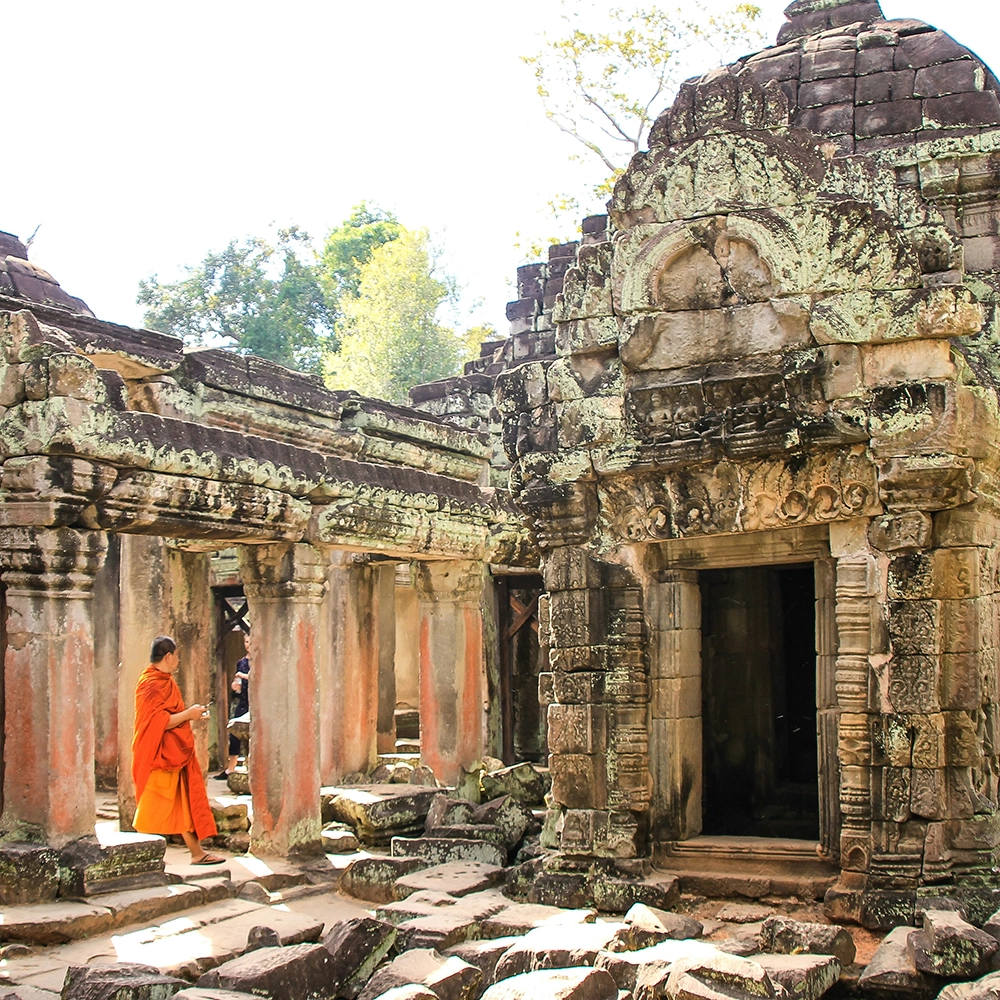Angkor Wat is one of the world's more popular tourist destinations on Earth, and every year, droves of travelers come from all over the world to miss the experience of a lifetime by not being fully present in one of the most full-on wonders of the civilized world.
This isn’t just your average Cambodia travel guide. Sure, we’ll cover the basics. But I’m also going to let you in on a little secret. If you really want to experience Angkor Wat — see it, feel it, understand it — you have to be present.
During a six-month stint in Asia, Angkor Wat caught me at a particularly mindful time in my travels. I’d just been at a month-long meditation and yoga retreat. Implementing the mindfulness lessons learned there allowed me to get a much fuller experience out of my visit, and I hope those same lessons can pave the way for you to get the most out of your trip to Angkor Wat and beyond.
Where is Cambodia?
Cambodia is in Southeast Asia. It borders Thailand, Laos, and Vietnam, with some coastline on the Gulf of Thailand.
The capital of Cambodia is Phnom Penh (pronounced puh-NAAM pen). It’s located in the southern part of the country, about 150 miles (240 kilometers) from the border with Vietnam.
Is Cambodia Safe to Visit?
As of June 2024, the U.S. State Department had placed Cambodia under a Level One travel advisory, recommending travelers exercise normal precautions.
If that low-level advisory surprised you, you aren’t alone. Many travelers, especially Americans, still have a perception of the country that comes from the Cambodian genocide in the 1970s when, during a four-year span, the Khmer Rouge political group killed nearly a quarter of Cambodians.
Cambodia is now a constitutional monarchy. You’ll find sites around the country addressing the genocide. While they may be difficult to visit, they do demonstrate how Cambodia’s dark history continues to impact the country today.
Best Places to Travel in Cambodia
Phnom Penh
The capital city has been described as everything from beguiling to chaotic to charming to lively. So that should give you some idea of what to expect — the unexpected.
Phnom Penh has some disturbing history, which you can learn about at the Tuol Sleng Genocide Museum. Once a high school, the building was turned into a prison by the Khmer Rouge in 1975. Tens of thousands of people were held at the prison — tortured and photographed and documented in gruesome detail — before being taken to the Killing Fields of Choeung Ek.
The museum is hard to stomach and not recommended for children. Hire a guide to get a better understanding of the history and its impact on present-day Cambodia.
For a lighter visit, head to the Royal Palace. Parts of the palace, specifically the Throne Hall and Silver Pagoda, are open to the public. Other areas are closed since it is where the king lives, but because it’s his residence, you’ll often see locals come to the complex to pay their respects, especially on Sundays.
Don’t forget to do some shopping at the Russian Market or head to the night market for street food galore. The night market is located along the tourist docks on Sisowath Quay, which is a major hub for riverside activity.
Elephant Valley Project
Southeast Asia is renowned (or notorious, in some instances) for its elephant tourism. It can be tough to tell whether the elephant tourism is ethical or not, but the Elephant Valley Project in Mondulkiri, Cambodia, is known for being some of the good guys.
Rather than riding elephants or expecting them to do tricks for you, tourists venture out into the wilderness where you can observe the giants in their natural habitat. The sanctuary provides a safe environment for the elephants to live out their retirement as well as contributes to local charities that aid with education and poverty.
Koh Ker
Considered by some to be an alternative to Angkor Wat, Koh Ker Temple (pronounced ko-kayer) in the forests north of Siem Reap, is nearly as big. Among the 40-something structures, you’ll see tiered pyramids and other massive stone ruins.
Unfortunately, Koh Ker has been looted over the years. This partly explains why it’s less popular than Angkor Wat, which isn’t too far away.
Its location also explains some of the looting and why it’s less popular. Koh Ker is more remote and difficult to get to, meaning thieves have largely gone unnoticed and fewer tourists take the time to explore off the beaten path.
Battambang
If the crowds of Phnom Penh and Angkor Wat feel too, well, crowded, head for Battambang in northwestern Cambodia. It’s a French colonial-era town with easy access to the countryside. Rent a bike or book a bicycle tour to take you past monasteries, through farmland, and maybe even learn about rice wine from a local business.
Battambang is also a favorite spot to try authentic Khmer cuisine. Be sure to order the Cambodian national dish, fish amok. It’s a fish curry that’s marinated in a lemony kroeung paste and coconut cream, then steamed in a banana leaf.
Siem Reap
If you’re in Cambodia, you have to visit Angkor Wat (although if you’ve made it this far, you probably already knew that). Angkor Wat is in Siem Reap, which along with the temples, is home to the floating village of Kompong Phluk and the Cambodian Land Mine Museum, both of which are worth a visit.
But back to the temple. During my time in Cambodia, I visited Angkor Wat because I felt like I had to. Eight years prior, I opted to skip Machu Picchu in Peru to eat guinea pigs with locals in Lima, and I've never heard the end of it.
That was also the year I was held up at the Panamanian border for not having the yellow fever vaccination, and the year I was kicked out of a club in Nicaragua for bringing a table on the dance floor, so it was not exactly a year of the best choices.
In hindsight, I cannot believe that I was lukewarm about visiting Angkor Wat. Clearly, I had been on the road too long and was suffering from SIAS — Seen It All Syndrome. Angkor Wat ended up being a more moving experience than I imagined it could be. The way I visited likely contributed to that.
Where is Angkor Wat?
If you haven’t guessed already, Angkor Wat is in Cambodia, Siem Reap to be specific. It’s part of the Angkor Archaeological Park, which covers 400 square kilometers.
To get to Siem Reap, you’ll travel northwest from Phnom Penh. It’s either a five-hour drive, which takes you through much of the central part of the country, or a 45-minute flight.
When Was Angkor Wat Built?
The temple complexes of Angkor Wat, Cambodia, make up the largest religious monument in the world. When construction began in the 12th century, it was designated as a Hindu temple, which gradually became Buddhist as the religious culture shifted.
In the 16th century, the first Western visitors arrived, and one Portuguese monk described Angkor Wat as having an "extraordinary construction that is not possible to describe with a pen, particularly since it is like no other building in the world."
It seems there’s always a downside to this kind of awe. More and more ... and more tourists have been gravitating toward Angkor Wat over the centuries. The priceless temples are now in danger from overtourism, and UNESCO has placed Angkor Wat on its list of endangered sites.
Thousands of visitors flock to Angkor Wat each day, contributing to a water crisis, degradation of the structures themselves, and forced relocation of local communities.
The battle against overtourism — something the original builders probably never imagined — is something to consider when planning a Cambodia trip. If you can, visit during the offseason when crowds are smaller and your impact on the environment is less. And whenever you visit, do so respectfully and in a way that contributes the greatest amount of positive impact.
How to Visit Angkor Wat
There are as many ideas out there of "how to visit Angkor Wat" as there are temples to visit. In other words, hundreds upon hundreds. You could spend a lifetime exploring the temples of Angkor Wat, and some archeologists have.
For the lay tourist, there are three choices: day pass, a three-day pass, or a weeklong pass.
How many days should you visit Angkor Wat?
Guidebooks on this topic disagree as much as your fellow travelers. One Canadian I talked to said, "There's really no reason to get more than a one-day pass. Once you've seen a few of the temples, you've seen them all."
This was much different than the Swiss traveler I talked to in a hot air balloon where we were getting a 10-minute aerial view for $20 (I highly recommend). He was on his fifth trip to Cambodia to see Angkor Wat and still opted for a weeklong pass.
I asked him why he kept coming back and he glanced at me with a look of aged wisdom explaining accumulated secrets to whimsical youth. "It's Angkor Wat. It's the greatest wonder on Earth!"
Three-Day Itinerary for Angkor Wat
Day One: Leave your map and camera behind
For your first day in Angkor Wat, I recommend that you leave your camera at the hotel. As sacrilegious as it sounds, this is exactly what I did, and what I saw was temples and selfie-stick zombies.
As kids of modernity, we can nary see a kitten doing something cute before a craving forces our hand into our pocket to pull out our smart phone to snap a photo. Being in Angkor Wat is like a million adorable kitties, and the impulse to capture every inch on camera is unavoidable.
There will be time later to take photos. On day one, just be present.
On day one, I brought neither a camera nor a map. I let myself get lost walking from the main temple to the secondary temples nearby. I walked slowly. I breathed deeply. I just took it all in. I felt connected to the millennia of history I walked upon and through.
Everyone else seemed in as much of a hurry as I likely did on days two and three. I met few other travelers who did not have a camera in hand with their fingers hovering above the shutter. To each their own, sure. But there are some experiences that are minimized in proportion to the number of photos we feel the need to take.
Day Two: Bring your camera and map
There is a time and place for everything, and the second day is a great time to revisit the main temple complex where you started the day before. And now you’ll be armed with your camera, map, and (if you must) your selfie stick.
This way you will be able to focus on taking a good photo instead of trying to simultaneously take in Angkor Wat for the first time, which to me feels the same as last-minute Christmas shopping at the mall (which could just as easily be dubbed a mini-panic attack).
Day Three: Get yourself some wheels
For my third and final day in Angkor Wat, I rented a bicycle from my hotel for the staggeringly cheap price of $1 per day, and I cruised around seeing as much as I could.
Since this was my last day, I took plenty of stops to snap photos. I did not have a selfie stick, but I found that with a bit of duct tape (always bring duct tape everywhere), a branch, and the timer on my iPhone, a DIY selfie stick is available wherever trees grow.
While the climate is hot and humid in Angkor Wat, the terrain is flat and easily navigated by bicycle. Just remember to bring enough water to stay hydrated. While there are places to buy water near the main temple, you could go for miles on some routes without being able to top up. Plan well and always bring more water than you think you need.
If you do not want to work up a sweat, you should be able to rent a tuk-tuk for $20 per day. After two days on foot, this is the more relaxing option.
Your hotel should be able to arrange a tuk-tuk for you, or you could bargain for one in the streets of Siem Reap. Expect to have to haggle with a gaggle of aggressive but agreeable drivers.
For those who want a driver who is knowledgeable about the history of Angkor Wat, I recommend arranging a driver or guided tour through one of the countless Cambodian travel agencies dotting the streets of Siem Reap.
This is by no means the only way to see Angkor Wat, but it's a solid one that gives this magnificent site its due. Visiting Angkor Wat appears on many travel bucket lists. There is a lot to see, but there are also levels of experience and history in every scene that you'll miss out on if you don't spend some time slowly taking it all in.
Travel Insurance for Angkor Wat and Cambodia
When visiting from another country, it’s always recommended to get travel insurance for Cambodia. Look for a plan that includes coverage for medical expenses if you get sick or hurt during your trip.
Some of the most stunning sites in Cambodia are in remote areas, meaning finding adequate medical care can be difficult. If you find yourself in an emergency situation, Seven Corners can help you find a hospital and, worst case scenario, arrange for a medical evacuation so you get the care you need.
Get a quick quote for travel insurance before you travel in Cambodia. Our licensed agents can also help you customize your plan to fit your individual needs and budget.




